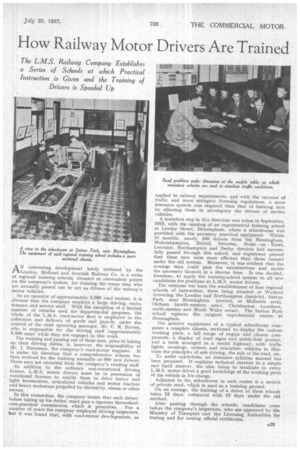How Railway Motor Drivers Are Trained
Page 39

If you've noticed an error in this article please click here to report it so we can fix it.
The L.M.S. Railway Company Establishes a Series of Schools at which Practical Instruction is Given and the Training of Drivers is Speeded Up
N interesting development lately initiated by the
London, Midland and Scottish Railway Co. is a series of regional training schools, situated at convenient points on the company's system, for training the many men who are annually passed out to act as drivers of the railway's motor vehicles.
As an operator of approximately 3,500 road motors, it is obvious that the company employs a large driving, maintenance and service staff. With the exception of a limited number of vehicles used for departmental purposes, the whole of the L.M.S. road-motor fleet is employed • in the collection and delivery of goods and parcels, under the control of the chief operating manager, Mr. C. R. Byrom, who is responsible for the driving staff (approximately 5,000 men) while they are engaged in this work.
The training and passing out of these men, prior to taking up their driving duties, is, however, the responsibility of Mr. J. Shearman, the company's road-motor engineer. It is under his direction that a comprehensive scheme has been evolved for the training annually of 1300 new drivers.These men are recruited from the company's existing staff. 'In addition to the ordinary non-vocational driving licence, L.M.S. motor drivers must be in possession of vocational licences to enable them to drive heavy and light locomotives, articulated vehicles and motor tractors and heavy motorcars propelled by electricity, steam or other means.
In this connection, the company insists that each driver, before taking up his duties; must pass a rigorous theoreticalcorn-practical examination which it prescribes. For a number of years the company employed driving inspectors, but it was found that, with road-motor developments, as
applied to railway requirements, and with the increase of traffic and more stringent licensing regulations, a more intensive system was required than that of training men by allowing them to accompany the drivers of service vehicles,
A tentative step in this direction was taken in September, 1935, with the opening of an experimental training school at Lawley Street, Birmingham, where a schoolroom was provided with the necessary practical equipment. Within 10 months, nearly 140 drivers from the Birmingham, Wolverhampton, Bristol, Swansea, Stoke on Trent, Leicester, Northampton and Derby districts had successfully passed passed through this school, and experience proved that these men were more efficient than those trained under the old system. Moreover, it was evident that the average man could pass the examinations and secure the necessary licences in a shorter time. It was decided, therefore, to apply the training-school system to all new candidates for positions as L.M.S. motor drivers.
The outcome has been the establishment of four regional schools of instruction, these being situated at Watford (covering the London and Northampton districts), Sutton Park, near Birmingham (central, or Midlands area), Oldham (north-western area), Cleckheaton (northern, north-eastern and North Wales areas). The Sutton Park school replaces the original experimental centre at Birmingham.
The interior equipment of a typical schoolroom comprises a complete chassis, sectioned to display the various working parts, a full range of engine and chassis components, a display of road signs and safety-first posters, and a table arranged as a model highway, with traffic lights, crossings, corners and miniature vehicles to illustrate the principles of safe driving, the rule of the road, etc.
To assist candidates, an intensive syllabus manual has been prepared. It explains technical matters in a simple and lucid manner, the idea being to inculcate in every L.M.S. motor driver a good knowledge of the working parts of the vehicle in his charge.
Adjacent to the schoolroom in each centre is a stretch of private road, which is used as a training ground.
On an average, The training of a driver at these schools takes 12 days, compared with 18 days under the old method.
After passing through the schools, candidates come before the company's inspectors, who are approved by the Ministry of Transport and the Licensing Authorities for testing and for issuing official certificates.




























































































